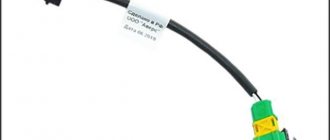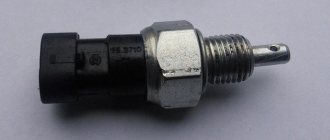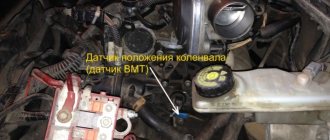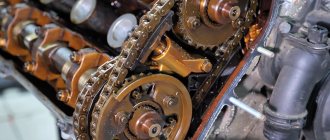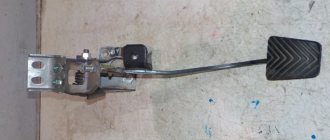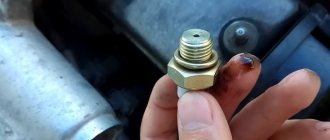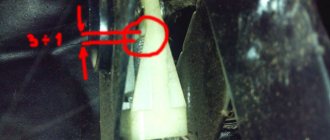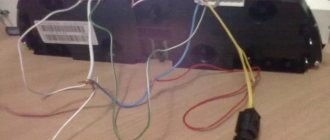10.03.2020
| (Votes: 1, Rating: 5) |
Issues discussed in the material:
- Meaning and design of the clutch
- What is a clutch pedal sensor used for?
- Clutch pedal sensor malfunctions
- How to repair and replace the clutch pedal sensor
The clutch pedal sensor is responsible for the smoothness of speed at idle and during shifts, and also affects the operation of cruise control. Malfunctions of this element will be noticeable immediately, and the driver’s task is to fix the problem in a short time.
There is nothing difficult in troubleshooting and replacing the pedal position sensor - even a novice motorist can remove and replace it by following the instructions given in the article. In addition, the number of necessary tools is small, and there is nothing specific among them. Also in the material we will tell you in more detail about the device and function of this sensor.
Repair and service
On the latest models of VAZ cars equipped with an electronic gas pedal, a clutch pedal position sensor . Let's consider why it is needed, the principle of operation and possible malfunctions.
Where is the clutch sensor installed on VAZs?
The clutch pedal position sensor on VAZ is installed directly on the clutch pedal bracket; it can be seen by looking under the steering column.
What is a clutch sensor used for?
The clutch pedal position sensor is one of the elements of the engine management system with an electronic gas pedal. This sensor provides a more flexible control scheme for engine modes. It simplifies the process of starting to move, eliminates “drops” and jerks of the car when changing gears in the manual transmission, and also allows for a reduction in fuel consumption.
By providing information to the engine controller about the moment the clutch is engaged and disengaged, the clutch pedal position sensor allows it to reduce or increase engine speed at the right moment, as well as adjust the ignition timing.
Working principle of the clutch sensor
The clutch pedal position sensor is an ordinary limit switch with two positions - “on” and “off”.
Its normal position is open, that is, it turns on only when the clutch pedal is pressed.
Clutch position sensor malfunctions
The following symptoms may indicate a malfunction of the clutch pedal position sensor
- car "pecks" when changing gears
- a sharp increase or decrease in engine speed when the clutch is disengaged
Also, if a malfunction occurs in the clutch pedal position sensor , error 0830 “Clutch pedal sensor error” is recorded in the engine controller and the “Check Engine” light in the instrument cluster turns on.
Error 0830 is detected if the engine controller does not receive a signal from the clutch sensor:
- within 2 seconds after changing gear while driving
- after four gear changes at speeds above 10 km/h and engine speeds above 1000 rpm
The main reasons for error 0830:
- malfunction of the clutch sensor itself
- short circuit or open circuit
- Incorrect clutch pedal height
We encountered error 0830 while preparing the material “How to get there without a clutch?” We recorded video instructions on how to change gears without a clutch. After several gear changes without disengaging the clutch, the “Check Engine” light came on on the panel, which went out only after several dozen gear changes in normal mode.
Clutch sensor price
On many VAZ cars with an electronic gas pedal there is a connector for this sensor, but there is no sensor itself. It is not clear whether they forget to install it at the factory, or whether careless dealers remove it. The second option is also quite possible, since this sensor is still in great short supply. It costs an average of 350 rubles, but finding it on sale is almost impossible.
of clutch pedal position sensors for VAZ cars:
- 21214-3720020-02 for Lada 4×4 cars with electronic gas pedal
- 1118-3720015 for Kalina, Grant and Priora cars with an electronic gas pedal.
They are not interchangeable with each other. It would seem like a simple sensor, but how much it can complicate the life of an ordinary car owner.
Diagnostic features
To diagnose the operation, you must first call the contacts individually, and then in pairs. If pins 2 and 3 are disconnected, this may indicate that they are faulty, especially since the other pins are making loud noises (video by Stas Garage).
To diagnose the work, you must first visually inspect it to see if there are any cracks or breaks. Then test the contacts to determine if there is a short circuit or break in the wire. In the event of a break, short circuit or corrosion of the wires, dismantle the part. How this simple manipulation is performed is below.
Where is the clutch sensor located and why is it needed?
A special Grant clutch sensor is attached to the pedal bracket itself. You can see it by looking under the steering column. The stabilizer is a fairly simple design in the form of a limit switch. When not activated, it has the “Off” position. The element is activated only when the clutch pedal is pressed.
The electronic clutch control system ensures correct engine operation and rapid switching to a new mode. When you press the pedal, the stabilizer is activated and transmits the corresponding signal to the control unit.
Thus, the Grant clutch pedal sensor allows you to optimize gear shifting and eliminate speed jumps when changing speed modes, as well as unstable engine operation (jerks).
Possible breakdowns
Since the sensor is a kind of limit switch that works on/off, there are two options: pressing the pedal and releasing the pedal. Inside the sensor there is a special spring-loaded plastic, which can explode over time and therefore the return mechanism of the sensor will not work, which will lead to a constant closure of the contact and the ECU will receive a signal that the clutch pedal is in an inoperative state and is constantly pressed.
Also, the sensor control circuit is connected to it by soldering; most often, the wires are separated from each other by soldering, breaking the circuit. Upon inspection, it is quite easy to identify such a problem.
What is a clutch pedal sensor used for?
In order for the engine to function normally, you need to know what mode the clutch is in. For example, when it is open, fuel will be supplied in a smaller volume, and the engine speed will also decrease. Moreover, the changes made must correspond to the current speed of the machine; switching should not occur at idle.
When a motorist does not have enough driving experience, he makes mistakes, as a result the clutch and motor wear out. The on-board computer reads the readings from the clutch pedal sensor to control the engine operating mode, selecting the desired speed. In addition, it, together with the speed sensor, transmits information to the computer about the state of the internal combustion engine, and also warns of breakdowns.
A clutch pedal position sensor is installed in the car to:
- reduce fuel consumption;
- make driving comfortable;
- monitor the condition of the coupling;
- increase the service life of the mechanism.
How long the entire mechanism will last and how much fuel the machine will consume depends on its proper operation. It also affects the functioning of the electronic control unit. It operates exactly the same as a standard limit switch. If the pedal is released and the mechanism is turned on, the sensor contacts will be open. As soon as the driver presses the clutch drive, the limit switch closes. The electronic control unit will receive a signal that the disk and basket have become disconnected.
The device is located in the place where the pedal is attached so that the end of the pedal comes into contact with the limit switch.
Replacing the clutch pedal sensor is rarely required, because its design is simple and it rarely fails. However, it still has to be replaced if it malfunctions or is damaged.
How does the electronic engine management system work?
The electronic engine control unit controls most of the vehicle's components, excluding the steering and suspension. ECU programs include presets (tables), according to which optimal operating modes are calculated. Many sensors installed on the car read information about speed, movement, engine speed, activated mechanisms and units. Based on the tables, the ECU changes the ignition mode, turns on additional functions and regulates the composition and amount of the air-fuel mixture entering the cylinders.
Signs of a malfunction of the Priora clutch sensor
This sensor is connected to the car’s ECU; accordingly, the first sign of a breakdown is the reaction of the control unit in the form of the appearance of a corresponding signal on the dashboard. The nature of movement and operation of the car engine also changes. Symptoms of malfunction are as follows:
- The “Check Engine” light is on;
- when starting to move the car jerks;
- When you press the clutch pedal, the engine speed rises or falls sharply.
The warning lamp on the instrument panel lights up if the computer does not receive a signal from the clutch sensor within 2 seconds from the moment the vehicle starts moving or within 4 seconds when changing speed while the vehicle is moving.
The sensor has a very simple design, so there are few reasons for failure:
- faulty sensor contacts;
- break or short circuit of the wires going to the sensor;
- Incorrect installation of the sensor near the pedal.
Important: the clutch sensor is installed only on Priora models equipped with an electronic throttle. If the car is equipped with a regular throttle cable, there is no clutch sensor. Also, when replacing a sensor, you should focus on its model. Sensors from all-wheel drive VAZ and Priora sensors are not interchangeable.
Carrying out an inspection
To perform the procedure for checking the brake pedal sensor on a Grant, you will need to turn on the ignition, then press the brake pedal, paying attention to the brake lights - do they come on? The pedal should then be released, again focusing on the brake lights, which should now go out. If the brake lights do not light up, you should check the sensor itself, and also see if voltage is supplied from the battery to the wiring harness block.
During the test, circuit 1-4 must be closed and circuit 2-3 must be open. Then press the rod, usually chain 2-3 should close and chain 1-4 should open.
Similar sensors are installed on other VAZ models - Priora, Kalina and others, so the solution to the problem for these models will be exactly the same.
Review of Manufacturer Prices
Technical parameters of the roller: 100 x 60 x 20 mm, weight 0.05 kg.
| Manufacturer | Price, rub.) | Resource (Thousand km) |
| VAZ 11180-1602266-00 cable lead | From 250 | 25 – 35 |
| 11180-1602210-00 cable assembly | From 300 | —/— |
| 21901-1602210-00 cable assembly | From 300 | —/— |
| 1118-3720015-00 DS | From 370 – 450 | —/— |
Reviews
| № | Positive |
| 1. | Vasily: I’ve been driving a car for two years now and have no complaints about the DS. The pedal squeaked several times, a drop of grease was added, and the sound disappeared. The build quality of domestic vehicles is good. Timely maintenance of equipment is important. |
| 2. | Kirill: a year has passed since the purchase of the car, no investments except for oils and filters. All sensors are working properly. |
| 3. | Vladlen: after 35,000 km. mileage the engine error light came on. I took it to the service center, but they didn’t find the fault right away - it turned out that there was poor contact between the block and the wires on the DC. In all other respects there are no complaints. |
| 4. | Vladimir: for two years of active operation of the machine, there have been no capital investments, the mechanisms are working properly. My positive review of domestic technology. |
| 5. | Georgiy: at 20,000 km the clutch pedal squeaked, I lubricated it myself, there were no more problems. I've been using the car for a year and a half. |
| 6. | Vitaly: I have repeatedly heard negative reviews about the build quality of the Lada Grant. I can’t confirm because everything is fine for me. I carry out inspections in a timely manner, buy only original parts, and have them serviced at certified service stations. |
| 7. | Gennady: two years of active operation of the machine and no investments, with the exception of oils, fuel, filters. Domestic equipment is good, but requires careful inspection and timely maintenance. |
| Negative | |
| 1. | Ignat: The DS has flown for more than 15,000 km, so I went to the service center for a replacement. On top of that, the cable stretched. Primitive quality parts. I plan to sell and buy Lada Granta. |
| 2. | Vitaly: I bought a Grant a year ago, but now I regret that it’s not a Renault Logan. The quality of domestic transport is poor, the models are crude. |
| 3. | Victor: during the year of using the car, I went to the service station twice unscheduled for repairs. |
Instructions for replacing the brake controller
- Pump out the liquid.
- Place the vehicle on a support stand and remove the wheel.
- Use a wrench to unscrew the two wheel pins.
- Remove the brake drum.
- Then, using a screwdriver, pull out the hook of the upper tension spring and remove the part. Perform the same manipulation with the lower tension spring.
- Then remove the front pad and spacer bar, while disconnecting the pressure spring and lower the pad.
- Remove the shoe lever from the parking brake hole, straighten the cotter pin and remove it from the parking brake drive.
- Remove the washer and lever.
- Install a new block and assemble the part in the reverse order.
Re: Clutch sensor
Posted by bugens » Oct 18, 2012 12:16 pm
Re: Clutch sensor
Post by Sunny » Oct 18, 2012 12:37 pm
Re: Clutch sensor
Post by LM_74 » Oct 19, 2012, 00:21
Hello, dear Forum members!
Let me introduce myself. I, Mikhail Ledyaev, am the leading tester on topic 21214M. Having looked through your section, I realized that the worst evil is information hunger, a car with E-gas has been produced for more than 1.5 years, and there is not enough information “for the masses.” I will try to answer your questions in parts. First, some general information about what E-gas is. It is necessary to understand that E-gas is not just a replacement of a mechanical throttle valve drive with an electric analogue, but a completely different logic for controlling the engine’s operating process. Here on the Forum there was already a link to a TV VAZ video about E-gas, where the deputy head of the Engine Design Department mentioned it. I’ll try to “popularize” this idea a little. In the initial versions of electronic injection, engine control systems actually “copied” the operation of a conventional carburetor, i.e. mixture formation was organized based on the required amount of air and fuel consumed, depending on the angle of opening of the throttle valve, adjusted according to the amount of oxygen remaining after combustion. In a “rough” approximation, this is how the controllers of the BOSCH MP 7.0 family worked. Starting with M7.9 controllers. the control logic changed and the concept of “torque structure” appeared, i.e., in addition to the throttle opening angle, another control parameter appeared, which “told” the engine what maximum possible torque it could develop if it had an “ideal” mixture. But it is not possible to fully implement such an idea on a mechanical drive, because the controller cannot control the amount of incoming air, but only controls the fuel supply. E-gas solves this problem, i.e. The driver, by pressing the gas pedal, DOES NOT CONTROL the air supply, but SHOWS HIS DESIRE to accelerate or slow down or move at a constant speed, and the controller itself determines the amount of air required for this (the angle of opening of the damper) and the amount of fuel. With such engine control logic, in order for the car to be adequate to the driver’s desires, it is necessary to provide the controller with sufficient information about the adjacent systems of the car - primarily the brakes and the state of the transmission (closed or open). May our “engine experts” forgive me for such a free retelling.
